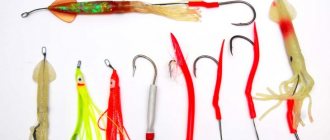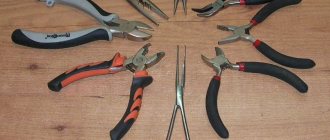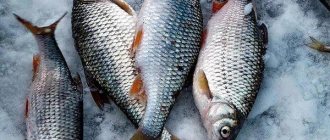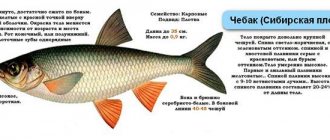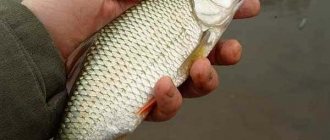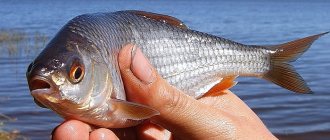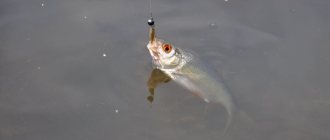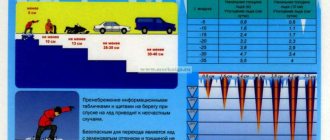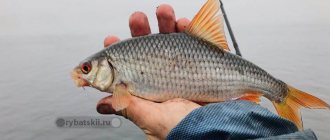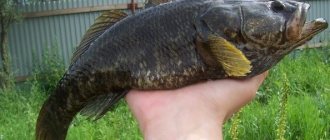Types of hooks
On sale today you can find a large number of these gears, which will differ from each other in size, shape, color, material of manufacture, and functions. The last point remains unclear to most amateur fishermen, but everything here is quite simple.
Each hook is designed for a specific type of fishing:
- It is not advisable to catch trophy specimens on a hook with a large shank, as they will get scared and will not take the bait.
Fishing with live bait; - For making a wobbler;
- To catch trophy species;
- Hooks for fly fishing.
Each product has one or more undershirts, so there is also a certain classification here:
- Single;
- Double;
- Triple;
- Blueberries;
- Fivers.
However, the last two types are quite problematic to find, since they are not particularly popular due to their low efficiency. According to their purpose, hooks also come in the following types:
- Catfish;
- Cyprinidae;
- Wobblins;
- Fly fishing.
The line is secured to the hooks using a special spatula or eyelet, and products with an eyelet began to be produced not too long ago - about a hundred years ago; before that, fishermen used hooks exclusively with a spatula.
It is very important to pay attention to the material from which such gear is made. In most cases, they are made from ordinary hardened steel. However, they are quite sensitive to the occurrence of corrosion processes. As a result, they last literally for one season, after which they become covered with a thick layer of rust and become fragile. Stainless steel gear is much more reliable and durable.
What places does the roach stick to?
Schools of roach on the current love to collect surface food.
In the second half of summer they can eat like this all day long. The habitats of roaches depend on the nature of the reservoir. Both standing and flowing reservoirs have their own characteristics.
If fishing is carried out on the current, you should look for roach in places around the bends of the river. In such areas, places with weak currents form. It is here, on the border between fast current and calm water, that this fish most often stands. At the same time, she grabs food floating by. If you place bait here on a float tackle, the bite will follow immediately.
It is worth paying attention to various objects at the bottom of the river. These could be flooded snags, thickets of aquatic vegetation, destroyed bridges and much more. Again, immediately behind such objects an area of calm water forms. Often, fish such as rudd, perch and chub stay here together with roach. So be prepared for variety. True, the roach stays more near the bottom. But the same chub occupies the upper water horizon.
Recommended reading: Brama sea bream
You can also find roaches in large holes and riverbeds. Moreover, the deeper the hole, the greater the likelihood of catching a trophy specimen. In addition, you can count on biting some other trophy fish. Because large fish almost always rest in large pits.
If in flowing reservoirs roach usually stays in strictly limited places and it is quite easy to detect them, then in standing reservoirs everything is not so clear. Here she has much more freedom of action. And often flocks migrate throughout the entire water area of the reservoir. Most often it stays on dumps. In those areas where there is a transition from a shallow depth to a significant depth. The upper part of such an edge is usually occupied by rudd. But at the foot of the edge you can count on a roach bite. Bream often coexists with it in such places.
In stagnant bodies of water, the “chebak” likes to stay in thickets of aquatic vegetation. Therefore, you can catch it by casting it out the window among aquatic vegetation.
Dimensions
When choosing a fishing hook, it is advisable to adopt the principle of numbering this element of gear. In our country, numbering from 2.5 to 16 mm has been in effect for several decades. Hooks with fractional sizes, for example, 2.5 or 4.5 mm, were also marked up to 9 mm.
All other products were numbered in the form of integers, and this indicator indicated the distance at which the forearm and sting were removed from each other. Not too long ago, an international classification was developed.
It is called the Reddic scale:
Determining the size
Every novice angler should be well versed in the gradation of this element of gear. The package with the hook must contain encrypted information regarding all the data that will be needed in order to make an informed choice. This is a set of alphabetic and numeric characters. If you know what each of them will mean, then you can easily determine how long the hook is, how thick its shank and width are.
It was experimentally determined that the most universal are numbers 5 and 6
The marking begins with Roman numerals, which indicate the following information:
- I – single hook, equipped with a spatula and having a single bend;
- II – single, having a spatula and a single bend;
- III – single, the fishing line on which is attached through a spatula and has a double bend;
- IV – single, having a ring and a double bend.
The next number indicates the width of the hook in millimeters. The last numerical value indicates how long the forend is.
In the domestic numbering of hooks, the smallest one is the one numbered 2.5. Amateur fishermen nicknamed it “swallow”. Its size is small, and it looks quite elegant. Suitable for fish with a small mouth, usually used for flies, maggots and other small baits.
To catch fish of larger sizes, as well as for experimenting with baits, you can use hooks with numbers 3 and 4. However, it was experimentally determined that numbers 5 and 6 are the most universal.
You can catch perch, small pike, carp, large crucian carp, bream and so on. For trophy specimens, even larger products will be needed - carp, grass carp and other large species are already caught with them. Catfish will require the use of only large hooks - the largest that can be found on sale.
Specific choice
To catch cautious fish, you can try using hooks of different colors, but at the same time they are taken to match the color of the bait.
Small fish do not bite too often, but the bites in most cases are quite sharp and short in time, when they have time not only to swallow the bait very deeply, but also spit out, causing the float to suddenly go under the water, and then return to its original position.
In this regard, for species such as rudd, roach, bleak, and sometimes white bream, it is best to use hooks with an extended shank and a side bend. The last element of the design is designed to prevent the fish from jumping off after a bite, and they are also quite easy to pull out of the fish’s mouth.
You need to catch small fish quickly, as the school moves from one place to another. Hooks numbered 14 and 18 are suitable here.
In principle, to catch cautious fish, you can try using hooks of different colors, but at the same time they are taken to match the color of the bait. If the fish is large, then the bait on the hook should also be larger. They also take a large hook, which has an increased bend of the tip and a rather short fore-end.
With the help of this tackle, the fish will sit tighter and stay on it well. In this regard, for fish such as ide, bream, chub or large carp, you should try to catch them on hooks with numbers from 10 to 16.
When going after a powerful fish, quite serious loads are created on both the hook and the fishing line along with the rod. Therefore, it is necessary to select large products made of thick wire. In principle, in this case there are no special requirements for the shape of the hook, the main thing is that the level of its strength is as high as possible.
Roach fishing tackle, hooks
There is a widespread opinion that saving on hooks costs more. And indeed it is. The normal performance of a good bottom roach hook is: one bite – one fish in the cage. However, to be more objective, for every ten bites there should be nine fish in the cage.
If a significant number of roach bites are not realized, especially if failures are common during fishing, then this hook is not suitable for roach.
Choosing a roach hook can begin with choosing the optimal shape. The shape of the hook should be well suited mainly for vegetable attachments (various doughs, star pasta, etc.). The size of the hook depends on the size of the bait, the size of the fish being caught and partly on the type of bait. And in each specific case you will have to select the optimal hook size. Moreover, the difference in rooms can be significant: from N18 to N8. If you take a hook smaller than what is required today, then when hooking it will often jump out of the fish’s mouth; if larger, then the percentage of empty bites will increase. To some extent, N10 can be considered a universal number on the river, but this is for heavy roach. For roaches weighing up to 150 grams, N12-14 is better, and with small baits, smaller hooks N16-18. When catching large roach on the bottom is greatly hampered by bleak and small silver bream, the N8 hook can help out, on which the roach sits quite normally.
Choosing the hook number is not so difficult, because usually roaches of similar sizes are moving around in the fishing area, and among these schools there are only a few larger roaches mixed together. But in the process of bottom fishing for large roach, you may need to adjust the hook size. For example, a fish can be capricious and only take a small bait, which would be better suited to a small hook.
Now about the color of hooks for bottom fishing for roach. Based on all the “book-bottom” advice, you need to prepare dark hooks, they say, donka means a dark hook. Cropping practitioners completely refute this statement and successfully use light-colored hooks, including shiny white ones. Some argue that such hooks can even slightly increase the roach's interest. But most opinions agree on one thing - the color of the hook should match the color of the bait.
And about one more very important point of the roach hook - the method of tying it to the leash. If you simply tie the fishing line to the ring of the hook, then the hook will often take the wrong position when fishing, and you can catch much less roach. Therefore, the knot must be located on the shank of the hook.
Blitz tips
- When purchasing a fishing hook, you should not give preference to too cheap products. They are capable of breaking or bending under the influence of the mass or play of the fish, as a result, it will simply jump off it and go into the depths. Cheap hooks are often blunt, which allows the fish not to bite on it, but simply eat the bait;
- Even an experienced fisherman is unable to select a reliable hook by eye that will catch big fish. Moreover, there are a large number of different models on sale. Usually experienced fishermen take the most catchy hooks with them to the store and begin to select such gear according to their image and likeness;
- Today, there is no consensus among fishermen about which way is better to attach the hook to the fishing line - through an eye or a spatula. However, recently they are starting to return to the spatula again, since a competent knot made on it will be much more reliable. In addition, there may be a sharp edge under the ring, which, if caught, can cut the fishing line and simply lose the hook. In the case of a spatula, a similar effect is not observed;
- If the fisherman does not intend to catch large fish, then it is best to take the thinnest hook. It does not weigh too much and allows you to use even quite delicate baits such as bloodworms without breaking it, since no fish will bite on such a bait - it will immediately become clear to it that they are slipping something that is not entirely necessary for it.
lakeking.ru
There are a lot of specialists who give advice on how to make this or that tackle, and not just tackle, but the most catchy and best. At the same time, the articles pay a lot of attention to the gear itself, the conditions of the reservoir where it is preferable to fish, hundreds of other important issues are voiced, but, unfortunately, very little attention is paid to the hook itself. At best, the authors will indicate the size of the hook, but usually they don’t do this either, hoping that the novice fisherman will figure out the hooks himself. In a number of cases, this is what happens: for example, I am never guided by the hook numbers that are indicated in the articles; I empirically independently select the number that is most suitable for specific fishing conditions.
If we delve deeper into the theory of a fishing hook, it should be noted that the hook has several conventional zones, which are often used in the literature, which means you need to know them:
1. Hook point. 2. Goatee. 3. Ring (ear). 4. Forend. 5. Prying up.
I note that the characteristics of each of these parts determine how the hook will perform its function. While practicing fishing for crucian carp and roach, I determined the following for myself:
1. I only use straight ring eye hooks.
2. The handguard must be standard.
3. Curved tip inward.
4. And most importantly, I choose hooks with the sting bent away from the forearm.
In my opinion, it is thanks to the bent tip of the hook that the quality of hooking increases significantly. I even conducted a kind of experiment: I fished with two fishing rods equipped with different hooks, and it was the hooks with the bent tip that had the least number of accidents. Otherwise, this type of hook is no different from ordinary ones (wire characteristics, strength, etc.), although for me personally it is somewhat more convenient to place animal baits (for example, a worm or bloodworm) on hooks with a bend.
Another point that I want to draw attention to is that in my float fishing box, all the hooks are black. For some reason, crucian carp, in our conditions, bite better on hooks of dark shades, ignoring colored ones, and roach prefers hooks of different color shades on different days.
By the way, a curved tip inside the hook provides a number of advantages: 1. The fish does not immediately feel the tip of the hook, which is important when catching cautious fish. 2. If a fish is hooked, it will most likely never come off the hook. 3. It seemed to me that such hooks have increased strength.
I strongly recommend that you try hooks with a curved tip to form your own opinion.
All the best to you.
© Author: Awpis especially for the portal Club-Fish.ru
fisherman2000.mirtesen.ru
I’m not one of the ardent fans of fishing, preferring to buy canned goods and fillets in the store, but my little son loves to spend time near the water. In the village where we send the boy to rest with his grandmother, there is a small river in which various small fry live. Tell me how to make the simplest tackle for roach, since this is what is most often caught in this reservoir.
To effectively catch roach in the summer (bottom tackle is used in the fall), it is enough to acquire an ordinary float rod with a rod length of 4-5 meters (a larger stick is more difficult for a child to hold).
They select the main fishing line with a thickness of 0.18-0.25 mm, winding it on a simple inertial reel. For long-distance casting, it is better to use a spinning rod. When using a fly rod, you can do without a reel. The diameter of the leads should not go beyond 0.18 mm (0.12-0.15 mm is suitable). The main load is a sliding droplet, and 3-5 small pellets are attached closer to the leash. The number and weight of lead peas should be combined with the float test.
Tackle for roach in summer is equipped with small hooks, and the length of the leash should not exceed 20 centimeters (10 is enough). It is not recommended to use large stings - the fish sees them well and does not even touch the attached bait. Hooks for catching roach must match the size of the bait. For dough, maggots, insects, No. 10 is suitable, for other baits – No. 8. Points with an elongated fore-end are used when fishing with a worm or in winter fishing, when the main bait is bloodworms.
Hooks for roaches can be tied to the undergrowth in any way, even without the use of special knots. But the leash itself is attached to the main vein using the classic “loop to loop” option. The choice of float for the tackle depends on the presence or absence of current. Since the roach pulls it down when biting, you should load the buoy before the beginning of the antenna, making the resistance small. The color doesn’t really matter, the main thing is that it suits all fishing conditions. The tricks to choosing a float shape are that in strong currents models with a spherical body work better, in shallows - in the form of a spindle, and at depths - in the shape of a drop.
The roach is in motion almost all the time and does not stand in one area of the reservoir. To keep the fish in a certain place, you need to use feeding. The food must also contain those ingredients that will be used as bait on hooks.
poklev.com
In this article we will talk about models specifically for float fishing rods. The hook is the most important component of equipment for float fishing. Its quality determines how successfully we hook the fish, and whether it will fall off during fishing. It largely depends on how attractive the hook and bait look to the fish whether a bite will take place at all. It is important to choose the right hook size for a specific bait and the predicted weight of the fish being caught.
Why such difficulties? After all, you can simply estimate by eye what kind of hook it is, how a worm, maggot, bloodworm, pearl barley, etc. will fit on it. Yes, an experienced floater, who has reviewed and tried many hooks in his life, can accurately choose the right one for himself in the store, without sharpening pay attention to the digital number. But it’s not always easy for him either, because some hooks today have an intricate shape.
It is important for many anglers to know the hook number while still in the store! Indeed, in any information of a practical nature (fishing books, Internet sites, newspapers, magazines, just fishing conversations) the number of the optimal hook for fishing of a specific size, type, for a specific bait is indicated.
In recent years, “Soviet” hooks have been mixed with foreign ones, and their classification has created a real vinaigrette. “Soviet” and foreign fishing hooks have different numberings. For “Soviet” ones, the number corresponds to the distance in millimeters from the point of the hook to the fore-end, that is, the “width” of the hook (Fig.)
It seems convenient, but not always accurate. Because if the sting is significantly turned towards the fore-end (and now there are many such hooks), then the number does not give a descriptive picture of the size of the hook.
In the international numbering of fishing hooks, everything is exactly the opposite: the smaller the model, the larger its number. You can give approximate numbers, where the first value is the “Soviet” number, and the second is the hook number according to the international classification, corresponding in size to the “Soviet” one. No. 2.5–No. 18; No. 3-No. 16; No. 3.5-No. 14; No. 4-No. 12; No. 5-No. 10.
Now you can determine the number of any hook yourself. Let's take a caliper (or even a metal ruler) and measure the distance from the tip to the forend. Let's say we get 4 mm. This means that this hook will be number four according to the “Soviet” numbering. We convert the number to international and get No. 12 - the actual size of the hook.
The declared number may not correspond to the real number. Firstly, the form may be different, and the most important thing is that there is simply no “general international” classification of hooks, and our old domestic numbering looks much better. It’s bad that there is no single international numbering, and different manufacturers number in their own way, based on unknown reasons.
As a result, a No. 18 hook from one manufacturer may be completely identical in size to another manufacturer's No. 16 hook. Moreover, even for the same brand, hooks of different models may have different numbers, for example, No. 18 and No. 14 may have the same distance from the tip to the fore-end. Moreover, these may not be some counterfeits, but high-quality branded products.
What might happen as a result? Let’s say a fisherman successfully caught a fish with hook No. 16 of a certain model - with this hook the fish was hooked normally, and there were few escapes. But hooks are consumables, and the favorites have run out. So it’s time to go to the store for “cool” No. 16. And there the “sixteens” are completely different - much larger (smaller), and of a different shape. What to do?
You will have to rely only on your eye, compare new hooks with the sizes of your own, already well tested ones. As a result, as they gain experience, fishermen come to the same conclusion, namely, they choose the hook size in the store by eye.
If you refer to a specific hook in any fishing information, then, taking into account the above, it is reasonable to indicate not only the number, but also the brand and model. At the same time, whether you want it or not, but regularly a specific brand, a specific model. Apparently this is what the “hook makers” intended, and the mess in the international classification of hooks is quite deliberate, but not at all useful for fishermen.
A universal hook is not a derogatory term at all, indicating the mediocrity of this element of float tackle. A good hook can have a universal shape that holds almost any bait well. After all, constant work with baits is the most important condition for successful fishing. Bait the bloodworm this way and that, hook the maggot to it, throw off the bloodworm and attach a piece of worm or pearl barley to the maggot.
In the process of these, such important experiments, you won’t constantly change the hook to one suitable for a specific attachment. And any fish can hatch, even if you’re not prepared for it. Instead of the expected roach, crucian carp, silver bream, white bream, perch may be suitable, and very often the fish are mixed together. That is why the universal float hook is one of the most popular.
This is a long-invented “bicycle” - a classic shape with a straight bend and an elongated fore-end, 2-2.5 times the width of the hook (a model similar to that noted in the figure, with slight variations in shape). But following modern trends that improve grip, the point of a universal hook is often turned somewhat towards the fore-end. By the way, in most cases, models of this universal shape are used by float swimmers in their competitions, where they need to catch a lot of different fish, lower them smaller ones and actively work with various baits.
Hook shape for a specific fish . Often the packaging bags indicate that these are for roach, and those are for bream. That is, it is understood that, taking into account the nature of the bite of a certain fish, the anatomy of its mouth, it is worth inventing a specially shaped hook with which you will catch the most.
Many floaters consider this complete stupidity, a kind of simple advertising ploy, leading to anglers buying not just a float hook, but hooks separately for bream, separately for roach, separately for crucian carp. The fact that such a technique is not worth a damn is said by the “hook” manufacturers themselves, who have their own vision of the ideal hook for catching a specific fish, and you can see specialized hooks that are radically different in shape. More important to success is the choice of hook size.
Hook size for fishing conditions. On the one hand, everything can be simplified and follow the unshakable float rule of all times and peoples - the size of the hook according to the bait and the fish being caught. Taking into account the size of traditional float baits and the main weight of the float fish (up to 300-500 g), two universal sizes can be noted: No. 4 (No. 12) and No. 2.5 (No. 18) - international size in brackets.
Models larger than No. 4 (No. 12) are, as a rule, already bottom-based and are used quite rarely in a float - when purposefully catching large fish with large baits.
However, here I would like to note an important point that occupied me and my friends, float fishing enthusiasts, many years ago, when we were upset about the lack of products smaller than No. 2.5 on sale. Please pay attention to this point: in fishing periodicals, some sports articles do not recommend floaters - those who like to use hooks smaller than No. 2.5 (No. 18), because with such a lot of fish, and the problem of lack of bite can be solved more simply, for example, move to another section of the reservoir, where there are more fish and the bite is more active.
At the same time, the athletes themselves usually use much smaller things from No. 18 to No. 26 in their competitions and training. At the same time, the most working number in many fishing conditions is No. 20. Fish actually escape from small hooks more often, but for some reason they are caught on them in competitions, where every failure is a gross mistake by the fisherman or simply insufficient quality of the hook. At the same time, they fish actively, on the verge of the strength of the leash, avoiding slack, parrying the jerks of the fish with a rubber shock absorber on fly and plug rods, a thin tip and a clearly set clutch with a reel float.
But it’s a pity that in their recommendations, some athletes imply that amateur fishermen and their equipment are not able to skillfully catch fish on small hooks, because this is far from true and is somewhat reminiscent of hiding a thorn in a bag.
Of course, the use of small models is not an end in itself, but a way to get cautious fish to bite on an appetizing but compact bait, for example, a single bloodworm. There is an almost direct pattern: the worse the bite, the smaller the hook and, accordingly, the bait, or the larger the fish, the larger the hook. However, this well-known rule is largely contradictory, because it is the large fish that is capricious most often, and here it is often a small hook that can save the situation.
Today, many fishing events differ little from float competitions. Moreover, during the spring movement of roach, bream, and large bleak on suburban reservoirs, the fisherman’s “zone” is often limited almost by the width of his shoulders - the floaters sit so closely in cool places, which on some days are oh-so-not cool. And here a small hook on a thin leash can be of great help. Naturally, when doing amateur fishing, you shouldn’t make a cult out of particularly small hooks, but it never hurts to have them in stock.
But what to do if on a particular fishing trip the bites of certain types of fish predominate? In this case, it is better to forget about the universal hook size. For example, there is targeted match fishing for large crucian carp weighing more than 400 grams. It would seem that you would need a large hook, similar in size to those used by many miners. However, in bottom and float fishing, the specifics of crucian carp bite are completely different, and in a match for many years I have not used hooks larger than No. 3.5 (No. 14), even if I come across trophy crucian carp weighing over 1 kg.
Here you just need to make sure that the hook is strong enough, that is, the wire from which the hook is made is thick enough. If you use large crucian carp bait, then of course you will need a larger hook, at least No. 4 (No. 12). And yet No. 3.5 (No. 14) is better, and a large worm is usually dressed not entirely, but in pieces 0.5 - 1 cm long. Since we are talking about crucian carp, we can note the following.
Some fishermen believe, and I completely agree with them, that with all the popularity of bottom fishing for crucian carp, donkeys have no chance of catching a float match rod in cases where large crucian carp approaches the shore at a distance of 30-40 m, especially when it “rubs” against the very coastal grass.
Carp is a very specific float fish, but match fishing for carp is still gaining popularity. But in carp match fishing, the use of small hooks (No. 16-No. 18 int.) is already extremely harmful, giving a lot of slips, which are usually caused by the fact that at the first jerk of the fish, the hook simply tears the oral cavity of the carp, especially if the hook is not thick enough.
However, I wouldn’t recommend being too impudent with the size of a carp float hook (taking the example of bottom fishers), and especially on paid ponds that are actively fished by fishermen, where many carp have already come off the hooks and have become smart. Therefore, taking into account traditional carp float baits (worm, maggot, corn, dough, etc.), for carp weighing up to 1 kg, I see the ideal float hook No. 12-No. 14 (int.), depending on the size of the bait. It was these small hooks that gave the maximum percentage of bites on carp beds, especially when the carp took weakly.
If you are targeting a much larger carp with a powerful match rod equipped with a high-quality reel, then larger hooks will be appropriate (No. 6 - No. 8 – international). These are not only more durable, but also allow you to bait fairly large baits that are less bothered by small things.
And yet, catching carp with large hooks is more of a bottom matter, where it is often planned to catch trophy carp, which few float tackles can cope with. But I can remember at least half a dozen fishing trips when the carp refused to bite on the bottoms, but only took one or two “float” bloodworms or small grains. Therefore, it was necessary to use a small (No. 16) hook made of thick wire on the float equipment.
Float bream fishing is often complicated by the need to carefully select the optimal hook size. For float bream from 1 kg and above, I consider the optimal hook to be No. 14, but if the bite is very careful, then I switch to No. 16 and even No. 18. At the same time, an interesting feature is observed: large bream come off small hooks much less often than small bream. For traditional white bream weighing up to 0.5 - 0.6 kg, in most cases a hook No. 16 is good. If there are a lot of escapes, which often happens when catching bream, then I use a slightly larger hook.
As for roaches of all sizes, when fishing with bloodworms and maggots, other small baits, when match float fishing I use only small hooks (No. 18-20). And only in cases where the roach prefers the worm, I use a larger model.
In recent years, among float hooks you can see less and less good hooks with a ring, and more and more with spatulas. The knot on the spatula is considered more compact, but it will only be reliable if it is tied very carefully, with dexterity, which appears after persistent training. I know one wonderful floater, a great admirer of the float, whom the surrounding “non-fishermen” consider to be completely unlucky.
And when they begin to remind you of the shortcomings of his character, he always retorts: “But I instantly tie the leash to a hook with a spatula, and the line on the knot does not lose strength, and you don’t really know how to knit fishing hooks.” And this is really an argument: that fisherman, among other things, will be able to quickly but flawlessly tie a thin fishing line to a small hook with a spatula with his eyes closed, and can consider himself a specialist in float fishing.
As for products with a ring, tying a leash to them is much easier. As a last resort, the fishing line can be tied to the ring with any knot and it will be more or less reliable. In any fishing book or magazine there are drawn knots that are used to tie hooks. The drawings, of course, give an initial idea of fishing knots and help in practical tying.
But the best option is to watch an experienced person how to knit hooks, and then, under his guidance, train yourself. In this case, the learning process will go much faster, because the teacher will be able to correct the slightest nuances of finger movements.
When tying a knot, you should always remember a few simple but very important rules. We try to lay the turns of the fishing line evenly, without distortions. We tighten the knot slowly enough so that the line does not overheat; during the tightening process, we control the turns of the knot so that they do not warp and are tightened turn to turn.
Before finally tightening the knot, it is very advisable to wet it, at least with your saliva or simply by dipping your hands in water and finally tighten the knot. A poorly tied knot leads to unpredictable breaks in the leader during fishing, annoying fish escapes and loss of hooks. It is carelessly tied knots that cause some anglers to lose faith in the leaders of their thin lines.
A good option is to tie up a supply of leashes at home in a quiet environment and store them on a leash. In this case, replacing the leash while fishing is a matter of seconds. By the way, knitting leashes can be good psychotherapy, akin to knitting a sock or sweater. I know one good fisherman who at one time, through negligence, froze almost everything he could in the winter, and since then he has only practiced summer fishing.
And now, during the long winters, after the cold and melancholy get to him, in his free time he either sits in the bathhouse, telling everyone what fish he caught in the summer, or knits leashes at home. For these purposes, he purchased a huge leash - a folder that holds an infinite number of leashes for all occasions, and knits hooks with his secret superknots. The slightest defect in the knot is immediately tied up. And during this procedure he is happy and calm, like a 0.5 mm fishing line under the pressure of bleak.
At the same time, he combines business with pleasure, because the entire open water season is provided with ready-made leashes for all cases of float and bottom life (unless, of course, he forgets his leash at home, which sometimes happens). On the other hand, if you don’t go fishing often, then there is little point in tying a significant supply of leashes. After all, if the leader is open (and most homemade structures are like that), then the fishing line deteriorates quite quickly, losing strength, especially if it is too dry and sunny.
lovimvse.ru
Classic Equipment Snap
The traditional rigging of a winter float rod for roach involves fishing from the bottom. This type of equipment can only be fished in standing or weakly flowing water bodies.
Since ice fishing for roach is rarely carried out at depths of more than 6 m, the carrying capacity of the float should not exceed 1.5 g. If you install a float with a higher carrying capacity, the tackle will be less sensitive.
The thickness of the main line should be from 0.10 to 0.14 mm. You should not use fishing lines of very small diameters, as they are more susceptible to tangling, which will cause the angler a lot of inconvenience while fishing. Using a fishing line that is too thick will make the entire tackle excessively rough, unable to respond to cautious fish bites. It’s good if the main line is dark in color. Dark monofilament is much more visible in the snow, which is very convenient for the fisherman.
As a rule, leashes are not used in traditional rigging. This is due to the fact that the hook and sinker lie on the bottom. In this case, the thickness of the monofilament is not critical, and you can do without a leash.
Particular attention should be paid to the distribution of weights on the fishing line. The main set of sinkers are placed 80 cm above the hook, which almost completely sink the float. A small sinker, which is placed 3 cm from the hook, should completely submerge the float under water. The total mass of the sinkers should be slightly greater than the total carrying capacity of the float.
During the fishing process, a hook and a sinker are located at the bottom, and the main set of sinkers is located at a considerable distance from the hook, which allows you not to alert the fish. When biting, the roach retracts the hook with bait, thereby lifting the sinker from the bottom. This action is instantly transmitted to the float, which, when bitten, begins to slowly float up.
Classic float tackle has a number of undeniable advantages over jig tackle:
- The bite alarm works great regardless of wind strength,
- the large mass of the equipment allows it to be lowered to the desired depth faster,
- You can fish with float tackle even in severe frost.
Since bloodworms are considered the most catchy bait on reservoirs without current, you should not use hooks larger than size 16. The use of small hooks allows the bloodworm to remain alive and move actively, which attracts the fish more and makes its bites more confident.
The classic rig works great not only when fishing for roach, but also when hunting for fish such as crucian carp and bream.
Classification of fishing hooks
According to the Russian classification, the hook number indicates the distance between the sting and the fore-end. If it, for example, is 5 mm, then the hook number will be fifth. This is the simplest numbering system. It also takes into account the thickness of the wire and the length of the entire hook. If, for example, on a pack of hooks there is the following inscription: No. 3—0.1—6, then this means that the hooks have the third number, they are made of wire 0.1 mm thick and have a total length of 6 mm.
Thus, according to Russian numbering, the higher the hook number, the larger it is. The opposite situation is in international numbering. In it, the size of a fishing hook does not reflect the distance from the sting to the shank. The number is tied to the length of the forend. But not directly, but with a difference of one unit. For example, hook No. 12 has a shank length of 11 mm. The higher the hook number according to international numbering, the smaller it is.
In general, the numbering of hooks was introduced by the English company Partridge of Redditch. Since then, hooks have been classified according to the Redditch scale. Many hook manufacturers indicate that their numbering corresponds to this scale.
On packages of hooks there are sometimes inscriptions such as 4X short shank or 6X long shank. These hooks have an elongated or shortened shank. The number indicates how much larger or smaller the handguard is. For example, a hook designated #12 2X short has the same shank length as a #14 hook. This classification is usually indicated for those who want to buy fishing hooks for fishing with artificial flies. Typically, such attachments are accompanied by optimal hook models with the above parameters.
For example, for tying a grasshopper, hooks with numbers No. 12 - No. 10 or 2X long No. 14 are suitable.
What is the best way to feed roaches?
If you want to return home with a decent trophy, then do not skimp on the bait mixture. Quite often, soil taken from the shore of a reservoir is used as a base for bait mixtures. It can be mixed with sweet cookies or breadcrumbs. After this, you can add food bloodworms or maggots to the resulting mixture. The bait should mold freely into balls. You can achieve the desired consistency either by adding soil to the bait mixture, or by adding water from the reservoir in which you are fishing to the bait mixture.
We recommend reading: Black Sea scorpionfish ruffe
How to feed during the current
If fishing is carried out on the current, choose the bait with which you can create a real edible cloud from the bait mixture. For these purposes, we focus on two points. Firstly, the basis of the bait should be a product capable of producing such a cloud. Secondly, the bait should be placed in a fine mesh net. A stone is placed in the same grid. After this, the net with bait is lowered at the fishing site. The current washes out the bait and carries it down. The roach standing downstream reacts to this fact and goes in search of a source of food. Ultimately, she approaches the bait bag, into the fisherman's fishing area. Now all you have to do is move the bait close to the potential prey. When fishing in the current, line fishing is usually used. But you can also lower the weight to the bottom, thereby making the equipment stationary. Either of these scenarios will result in the roach being caught.
When catching roach with a float rod, you can also use a special bite activator. A similar bite activator is added to the bait. Some additives not only serve as flavoring, but also make the fish hungry. The roach begins to feed and, of course, gets hooked.
Fishing hook sizes
Many fishermen will find this table useful.
In it you can find out how fishing hooks of different numbers relate to different classifications. The same numbering systems are used for double and treble hooks. If you take hooks from well-known manufacturers, then on the package you can read information about the diameter of the wire. You can also read for which type of fishing it is better to use hooks and for which fish.
Many manufacturers give sizes of fishing hooks at their own discretion. Therefore, if we take products from different manufacturers with different numbers for comparison, we will find that the distances from the tip to the forend are different. Experienced fishermen prefer products from well-known companies, and they already know that hooks from Ovner with No. 14 differ from hooks from Mustad with the same number.
